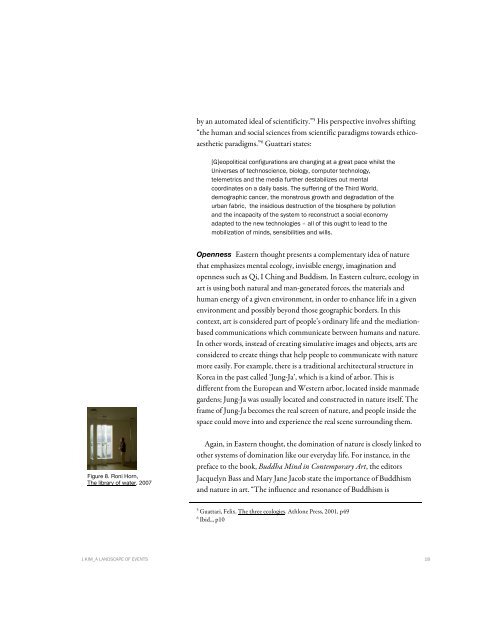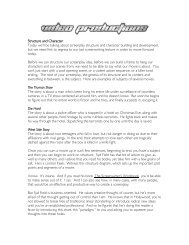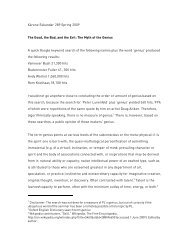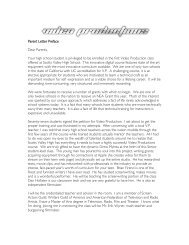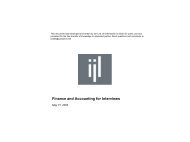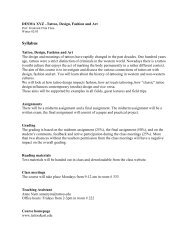UNIVERSITY OF CALIFORNIA Los Angeles - Users - UCLA
UNIVERSITY OF CALIFORNIA Los Angeles - Users - UCLA
UNIVERSITY OF CALIFORNIA Los Angeles - Users - UCLA
You also want an ePaper? Increase the reach of your titles
YUMPU automatically turns print PDFs into web optimized ePapers that Google loves.
y an automated ideal of scientificity.” 5 His perspective involves shifting<br />
“the human and social sciences from scientific paradigms towards ethicoaesthetic<br />
paradigms.” 6 Guattari states:<br />
[G]eopolitical configurations are changing at a great pace whilst the<br />
Universes of technoscience, biology, computer technology,<br />
telemetrics and the media further destabilizes out mental<br />
coordinates on a daily basis. The suffering of the Third World,<br />
demographic cancer, the monstrous growth and degradation of the<br />
urban fabric, the insidious destruction of the biosphere by pollution<br />
and the incapacity of the system to reconstruct a social economy<br />
adapted to the new technologies – all of this ought to lead to the<br />
mobilization of minds, sensibilities and wills.<br />
Openness Eastern thought presents a complementary idea of nature<br />
that emphasizes mental ecology, invisible energy, imagination and<br />
openness such as Qi, I Ching and Buddism. In Eastern culture, ecology in<br />
art is using both natural and man-generated forces, the materials and<br />
human energy of a given environment, in order to enhance life in a given<br />
environment and possibly beyond those geographic borders. In this<br />
context, art is considered part of people’s ordinary life and the mediationbased<br />
communications which communicate between humans and nature.<br />
In other words, instead of creating simulative images and objects, arts are<br />
considered to create things that help people to communicate with nature<br />
more easily. For example, there is a traditional architectural structure in<br />
Korea in the past called ‘Jung-Ja’, which is a kind of arbor. This is<br />
different from the European and Western arbor, located inside manmade<br />
gardens; Jung-Ja was usually located and constructed in nature itself. The<br />
frame of Jung-Ja becomes the real screen of nature, and people inside the<br />
space could move into and experience the real scene surrounding them.<br />
Figure 8. Roni Horn,<br />
The library of water, 2007<br />
Again, in Eastern thought, the domination of nature is closely linked to<br />
other systems of domination like our everyday life. For instance, in the<br />
preface to the book, Buddha Mind in Contemporary Art, the editors<br />
Jacquelyn Bass and Mary Jane Jacob state the importance of Buddhism<br />
and nature in art. “The influence and resonance of Buddhism is<br />
5<br />
Guattari, Felix. The three ecologies. Athlone Press, 2001, p49<br />
6<br />
Ibid.,, p10<br />
J.KIM_A LANDSCAPE <strong>OF</strong> EVENTS 18


